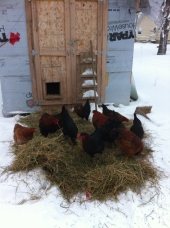I'll start by saying we got our first chickens in June of last year, so keep in mind I'm no expert as I type this stuff. We fed ours commercial starter then grower for the first 2 months. By that time I had found a source for organic feed; I live in Oklahoma and have to drive to a mill in Kansas for feed, nobody in Oklahoma sells or is willing to order organic. My chickens all did fine. I have a friend who raised a small batch of Australorps and bought a little bit of organic grower from me, he started his chickens on it at around 1 month old, his have all done fine.
As far as I'm concerned the first rule of chicken housing is try to make it pretty, or your wife is going to hate it. Just because I live in Oklahoma doesn't mean it has to look like it belongs in a trailer park. Now before I started building, I hadn't read Paul's treatise on paddock shifting chickens, so here's what I did:


I got the idea from a book published by Backwoods Home, where you set up your coop so chickens can exit either side. One year you let them out into a run on one side, then the next year they get the run on the opposite side. The idea is they poop and kill every bit of insect and vegetation to prepare your garden. Their waste you just shovel out one side and you have a ready made compost heap you can just drag into whatever side you're planting. And rainbows will shine overhead, unicorns will show up and poop marshmallows too.
What I do like about it, its off the ground. At least this way when there is a foot of snow on the ground, the chickens can go underneath and get real dirt to scratch around on. What I don't like about it: Its hard to get underneath to rake out the poop and straw that falls through. I wish I had made it a bit higher, but many of the dimensions of the coop were dictated by what material I had around the house, not what suited it best. The compost idea doesn't work so well. Sure I get a lot of poo and straw from the coop, but it turns out just dragging it out of the coop, then rotating the compost pile, then moving said compost into the garden is a lot of handling of poop. I'll discuss what I would do differently later. Also, I call the structure "Chicken Fortress 2000", because I was really worried about raccoons with superhuman strength who can tear poultry netting and have the intelligence to dismantle my coop. I dug a trench 1 ft into the ground around the bottom, put up chain link fence around the base, then put hardware cloth over that (since raccoons can reach through chain link), then concreted all that into the trench, one foot in the ground. I then sat back and dared any animal to try to dig underneath or break in by any means. Turns out my chickens just fly over the run fencing, and they coyotes get them when they're outside. This prompted me to put a bit taller fencing on it, so now the run/garden is almost 7 ft tall. By sheer luck I did buy cheaper green vinyl covered wire, which hides pretty well and doesn't look too gawdy.
My chickens do get to free range when I'm home, when I'm gone there are just too many predators. We didn't clip their wings because we thought if one of them gets out and is being chased by a coyote, it would be beneficial for the chicken to be able to fly. The problem/benefit with keeping them in one area is they kill any vegetation. So now if I plant a bed of asparagus or any other perennials, now you have to keep the chickens out of that bed when they're rotated back in. In the beds at the base of my cute little gate, I'm planting grapes and strawberries, I'm hoping it looks kick ass when covered in grape vines. But now I need to find a way to keep the stinking chickens out of it...year round.


So what would I do differently? The composting is too much work. The solution would be to get pigs to move the compost around. I haven't been able to talk my wife into getting pigs yet, and even if she was onboard, I still have to fence the other side of the coop before we plant our garden this year. I've never raised pigs, but I'm guessing they need a lot more fencing than chickens do. Instead of handling the compost more, I would leave the stairs off the back side to where I can just pull up with my atv and cart and fill the cart rather than making a pile on the ground then moving around the pile. If I had a skid steer or tractor with a bucket (on my wish list) I would put the chickens far away from the garden. We are about to deal with the problem of keeping chickens out of the food forest. We're planting quite a few fruit trees, and its just a matter of time before we have to figure out how to keep the chickens out of the trees and out of the mulch. Lots of other small problems I really don't have solutions to.














